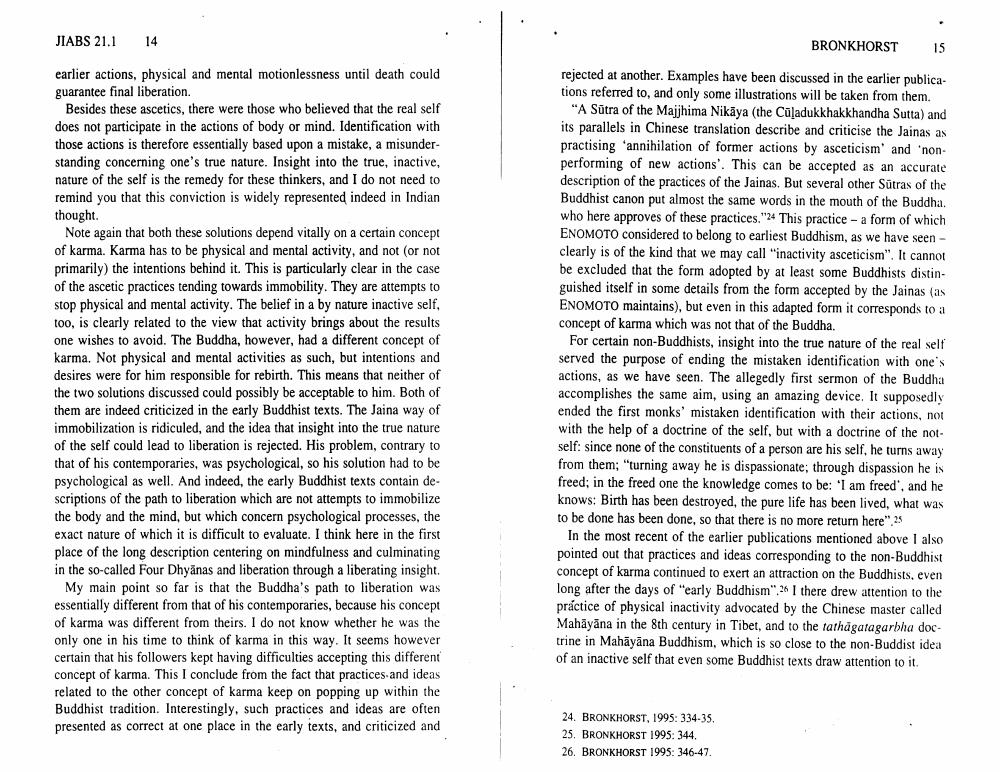Book Title: Did Buddha Believe In Karma And Rebirth Author(s): Johannes Bronkhorst Publisher: Johannes Bronkhorst View full book textPage 8
________________ JIABS 21.1 14 earlier actions, physical and mental motionlessness until death could guarantee final liberation. Besides these ascetics, there were those who believed that the real self does not participate in the actions of body or mind. Identification with those actions is therefore essentially based upon a mistake, a misunderstanding concerning one's true nature. Insight into the true, inactive, nature of the self is the remedy for these thinkers, and I do not need to remind you that this conviction is widely represented indeed in Indian thought. Note again that both these solutions depend vitally on a certain concept of karma. Karma has to be physical and mental activity, and not (or not primarily) the intentions behind it. This is particularly clear in the case of the ascetic practices tending towards immobility. They are attempts to stop physical and mental activity. The belief in a by nature inactive self, too, is clearly related to the view that activity brings about the results one wishes to avoid. The Buddha, however, had a different concept of karma. Not physical and mental activities as such, but intentions and desires were for him responsible for rebirth. This means that neither of the two solutions discussed could possibly be acceptable to him. Both of them are indeed criticized in the early Buddhist texts. The Jaina way of immobilization is ridiculed, and the idea that insight into the true nature of the self could lead to liberation is rejected. His problem, contrary to that of his contemporaries, was psychological, so his solution had to be psychological as well. And indeed, the early Buddhist texts contain descriptions of the path to liberation which are not attempts to immobilize the body and the mind, but which concern psychological processes, the exact nature of which it is difficult to evaluate. I think here in the first place of the long description centering on mindfulness and culminating in the so-called Four Dhyanas and liberation through a liberating insight. My main point so far is that the Buddha's path to liberation was essentially different from that of his contemporaries, because his concept of karma was different from theirs. I do not know whether he was the only one in his time to think of karma in this way. It seems however certain that his followers kept having difficulties accepting this different concept of karma. This I conclude from the fact that practices and ideas related to the other concept of karma keep on popping up within the Buddhist tradition. Interestingly, such practices and ideas are often presented as correct at one place in the early texts, and criticized and BRONKHORST rejected at another. Examples have been discussed in the earlier publications referred to, and only some illustrations will be taken from them. "A Sutra of the Majjhima Nikaya (the Cüladukkhakkhandha Sutta) and its parallels in Chinese translation describe and criticise the Jainas as practising annihilation of former actions by asceticism' and 'nonperforming of new actions'. This can be accepted as an accurate description of the practices of the Jainas. But several other Sütras of the Buddhist canon put almost the same words in the mouth of the Buddha. who here approves of these practices."24 This practice - a form of which ENOMOTO considered to belong to earliest Buddhism, as we have seen - clearly is of the kind that we may call "inactivity asceticism". It cannot be excluded that the form adopted by at least some Buddhists distinguished itself in some details from the form accepted by the Jainas (as ENOMOTO maintains), but even in this adapted form it corresponds to a concept of karma which was not that of the Buddha. For certain non-Buddhists, insight into the true nature of the real self served the purpose of ending the mistaken identification with one's actions, as we have seen. The allegedly first sermon of the Buddha accomplishes the same aim, using an amazing device. It supposedly ended the first monks' mistaken identification with their actions, not with the help of a doctrine of the self, but with a doctrine of the notself: since none of the constituents of a person are his self, he turns away from them; "turning away he is dispassionate; through dispassion he is freed; in the freed one the knowledge comes to be: 'I am freed', and he knows: Birth has been destroyed, the pure life has been lived, what was to be done has been done, so that there is no more return here", 25 15 In the most recent of the earlier publications mentioned above I also pointed out that practices and ideas corresponding to the non-Buddhist concept of karma continued to exert an attraction on the Buddhists, even long after the days of "early Buddhism" 26 I there drew attention to the práctice of physical inactivity advocated by the Chinese master called Mahāyāna in the 8th century in Tibet, and to the tathagatagarbha doctrine in Mahayana Buddhism, which is so close to the non-Buddist idea of an inactive self that even some Buddhist texts draw attention to it. 24. BRONKHORST, 1995: 334-35. 25. BRONKHORST 1995: 344. 26. BRONKHORST 1995: 346-47.Page Navigation
1 ... 6 7 8 9 10
